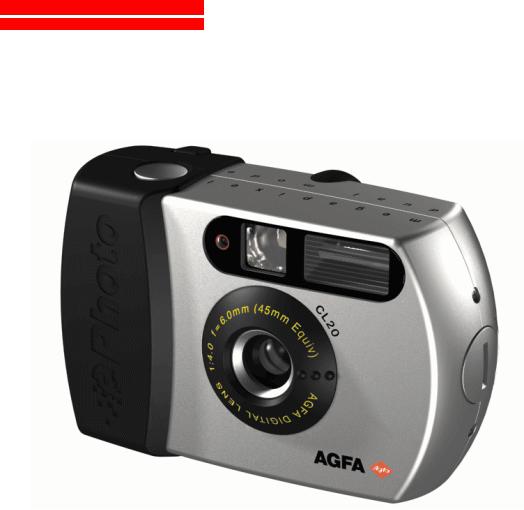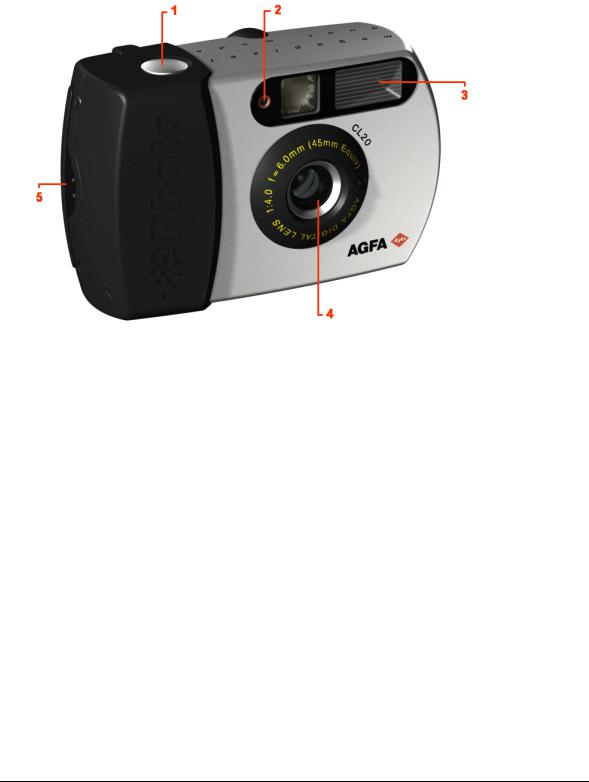AGFA ePhoto CL20 User Manual

ePhoto CL20
User’s Guide
ab

Trademarks
AGFA and the Agfa rhombus are trademarks of Agfa-Gevaert AG.
AGFAnet, AGFAnet Print Service, PhotoGenie, PhotoWise and ePhoto CL20 are registered trademarks of Agfa-Gevaert N.V.
Adobe Acrobat is a trademark of Adobe Systems Incorporated that may be registered in certain jurisdictions.
CompactFlash is a trademark of the SanDisk corporation.
Microsoft, Windows, Internet Explorer and NetMeeting are registered trademarks of Microsoft Corporation in the United States of America and in other countries.
VideoImpression is a trademark of ArcSoft Inc.
Other products or company names are trademarks or registered trademarks of their respective holders.
Copyright © July 2000 Agfa-Gevaert N.V.
All rights reserved.
All software and hardware described in this document are subject to change without any notice.
Trademarks 2

Regulation Compliance
FCC Information Test
FCC Warning: This equipment meets the limits for a Class B digital device, pursuant to Part 15 of FCC Rules. Only the power pack and cable supplied with the camera should be used. Operation with other power packs and cables is likely to result in interference to radio and TV reception and could void the user’s authorization to operate this equipment.
This device complies with Part 15 of the FCC Rules. Operation is subject to the following two conditions:
1.This device may not cause harmful interference.
2.This device must accept any interference received, including interference that may cause undesired operation.
Changes or modifications not expressly approved by the manufacturer may void the user’s authority to operate this equipment.
The limits for a Class B digital device, pursuant to Part 15 of the FCC Rules, are designed to provide reasonable protection against harmful interference in a residential installation. This equipment generates, uses and can radiate radio frequency energy and, if not installed and used in accordance with the instructions, may cause harmful interference to radio communications. However, there is no guarantee that interference will not occur in a particular installation. If this equipment does cause harmful interference to radio or television reception, which can be determined by switching the equipment off and on, the user is encouraged to try to correct the interference by one or more of the following measures:
!Reorient or relocate the receiving antenna.
!Increase the separation between the equipment and receiver.
!Connect the equipment into an outlet on a circuit different from that to which the receiver is connected.
Canadian Radio Interference Regulations
Statement
This Class B digital device meets all the requirements of the Canadian Interference-Causing Equipment Regulations.
Cet appareil numérique de la Classe B respecte toutes les exigences du Réglement sur le matériel brouilleur du Canada.
Regulation Compliance |
3 |

CE Declaration of conformity according to ISO/IES Guide 22 and EN 45014
This equipment complies with the requirements of the Low Voltage Directive 73/23/ECC, 93/68/ECC standards: EN 60950: 1995/A3.
This equipment complies with the requirements of the EMC Directive 89/336/ECC
Standards: |
EN 50081-1-EN55022 class B |
|
EN 50082-1-EN61000-4-2, EN61000-4-3, EN61000-4-4 |
Regulation Compliance |
4 |

Warranty
Agfa warrants this product to be free from defects of material and workmanship for one (1) year from the date of purchase. During the warranty period, Agfa will repair or replace, at its option, the product at no charge to the customer. The replacement unit may be a re-manufactured unit or a unit of equal or greater functionality. After one (1) year, Customer shall pay for all parts, labor and service.
Agfa warrants that software products will conform to published specifications in effect at the time of delivery for 90 days after purchase. Customer acknowledges that the Software may have inherent defects because of its complexity. The warranty applies only to the media on which the software is recorded. During the 90 days period, Agfa guaranties free support via the telephone. This support is not valid for third party software.
If a unit is replaced during the warranty period, the original warranty shall remain in effect until the end of the one (1) year period or shall be 30 days, whichever is longer.
This warranty is transferable with new owner notification to Agfa.
This warranty shall not apply if the customer:
!Abuses or modifies Product or Software.
!Operates the system in an environment with excessive dirt, moisture, chemical fumes, extremes of temperature or other improper conditions. The camera is not impermeable to water, dust or sand.
!Supplies other Software or Interfacing.
Warranty service is excluded if the serial number of the product has been tampered with or removed.
Caution: The parties agree that all other warranties, express or implied, including warranties of fitness for a particular purpose, merchantability and non-infringement, are excluded.
Warranty 5

Safety Information
!To reduce the risk of electric shock, do not disassemble the camera.
!To reduce the risk of fire or electric shock, do not expose the camera to rain or moisture. Refer all servicing to qualified service personnel.
!Only use the following batteries: AA Alkaline, AA Lithium or AA NiMh batteries. Do not use batteries that show signs of leakage, corrosion or swelling, or that are excessively warm.
Safety Information |
6 |

Care and Maintenance
!Avoid leaving the camera in the sun or in a very warm location (beach, car, and so on) for prolonged periods.
!Do not wrap the camera in cloth or plastic while it is on (heat and moisture may be trapped and damage the camera).
!Avoid using the camera in excessively cold (below 0°C/32°F) or excessively warm (above 40°C/104°F) conditions.
!When you bring the camera from a cold to a warm location, allow the camera to reach room temperature before you use it.
!If condensation develops inside the camera, stop using it immediately. Leave the camera at room temperature for a few hours to allow the condensation to evaporate.
!To clean the camera lens or LCD, blow away any surface dust or dirt. Then breathe on the surface to form a mist and gently wipe it with a soft, lint-free cloth or lens cleaning tissue.
!To avoid scratching the lens, use a gentle, circular motion when wiping.
!Never use harsh or abrasive cleaners on the outside surfaces of the camera. Wipe off dust with a clean, dry cloth.
Care and Maintenance |
7 |

Contents |
|
Introduction..................................................................................................................................... |
10 |
Chapter 1: Getting to Know Your Camera.................................................................................... |
11 |
Taking a Closer Look ................................................................................................................ |
11 |
Power Sources.......................................................................................................................... |
13 |
Batteries..................................................................................................................... |
13 |
USB Power ................................................................................................................ |
14 |
Memory Options........................................................................................................................ |
15 |
Internal Memory......................................................................................................... |
15 |
CompactFlash Memory Card (Optional External Memory)........................................ |
15 |
Camera Controls ....................................................................................................................... |
16 |
The REC/OFF Auto Return Switch ............................................................................ |
16 |
The Status Display..................................................................................................... |
16 |
The Mode Button ....................................................................................................... |
17 |
The Resolution Button ............................................................................................... |
18 |
The Delete Button...................................................................................................... |
19 |
Chapter 2: Recording a Still Image ............................................................................................... |
20 |
Chapter 3: Transferring Images to Your PC................................................................................. |
21 |
Installing the Required Software ............................................................................................... |
21 |
Connecting the Camera to Your PC.......................................................................................... |
22 |
Viewing and Saving Images on Your PC Using the AgfaCam Mounter.................................... |
23 |
Chapter 4: Organizing Images Using PhotoWise ........................................................................ |
24 |
Chapter 5: Ordering Prints Over the Internet Using AGFAnet Print Service ............................ |
27 |
Ordering Prints Using the Print Button ...................................................................................... |
27 |
Ordering Prints Using the AgfaCam Mounter............................................................................ |
28 |
Chapter 6: Using the ePhoto CL20 for Video Applications ........................................................ |
30 |
Videoconferencing with MS NetMeeting ................................................................................... |
30 |
Videoconferencing over the Internet.......................................................................... |
30 |
Videoconferencing over LAN ..................................................................................... |
30 |
Capturing Video Images with VideoImpression ........................................................................ |
31 |
Contents 8

Appendix A: Troubleshooting and Support ................................................................................. |
32 |
Troubleshooting ........................................................................................................................ |
32 |
Support...................................................................................................................................... |
32 |
Appendix B: Camera Specifications ............................................................................................. |
34 |
Contents 9

Introduction
The Agfa ePhoto CL20 digital camera can handle still images as well as video images. The following table gives you an overview of the possibilities of the camera:
Still images |
|
Video/Images over USB |
||
Using a CompactFlash™ Card (p.15) |
|
Transferring still images to your PC (p.21) |
||
! to store images on a CompactFlash |
! |
USB powered (no batteries needed) |
||
|
memory card |
! |
fast image download with the USB |
|
|
|
|||
! to (re)format your CompactFlash card |
|
|
interface at 300KB/s on your PC (this |
|
|
|
|
|
requires Windows® 98-2000) |
|
|
! |
to view images on your PC using |
|
|
|
|
|
AgfaCam Mounter |
|
|
! |
to order prints over the internet using |
|
|
|
|
|
AGFAnet™ Print Service |
|
|
! |
to manage images using PhotoWise™ |
|
|
|
|
||
Recording still images (p.20) |
|
Videoconferencing (p.30) |
||
! in Low resolution (512 x 384) up to 30 |
! |
USB powered (no batteries needed) |
||
|
images in the internal 1 MB camera |
! |
using the USB interface at 300KB/s on |
|
|
memory |
|||
|
|
|
your PC |
|
|
|
|
|
|
! at XGA in High resolution (1024 x 768) |
|
|
(this requires Windows® 98-2000) |
|
|
up to 10 images in the internal 1 MB |
! |
videoconferencing software using |
|
|
camera memory |
|||
|
|
|
Microsoft NetMeeting® or other |
|
|
|
|
|
|
! at PhotoGenie resolution (1280 x 960) |
|
|
videoconferencing software that supports |
|
|
up to 6 images in the internal 1 MB |
|
|
standard video for Windows drivers |
|
camera memory |
|
|
|
! |
with built-in flash and self-timer |
|
|
|
|
functionality |
|
|
|
|
|
|
||
Deleting still images (p.19) |
|
Capturing video images (p.31) |
||
! |
to delete images |
! |
USB powered (no batteries needed) |
|
"to delete the last image recorded ! using the USB interface at 300KB/s on
" to delete all images |
|
your PC |
|
|
(this requires Windows® 98-2000) |
||
! to clear the camera memory |
|
||
! |
video capture software using |
||
|
|||
|
|
VideoImpression™ |
#Note: To read more on your ePhoto CL20, visit: http://support.agfa.com/homeOffice.
#Note: Due to rescaling, some of the screen shots included in this document may appear unclear when displayed at 100% magnification. You can view these screen shots more clearly by using the Zoom tool to increase the default magnification.
Introduction 10

Chapter 1: Getting to Know Your Camera
Taking a Closer Look
1Shutter Button
To record an image or to confirm options of the Delete button.
2Timer Indicator
A blinking red light indicates that the selftimer is activated.
3Built-in Flash
To light dark scenes.
4Lens
Focal range = 65 cm (25.6 inch) to infinity.
5CompactFlash Slot
To insert an optional CompactFlash memory card.
Chapter 1: Getting to Know Your Camera |
11 |
